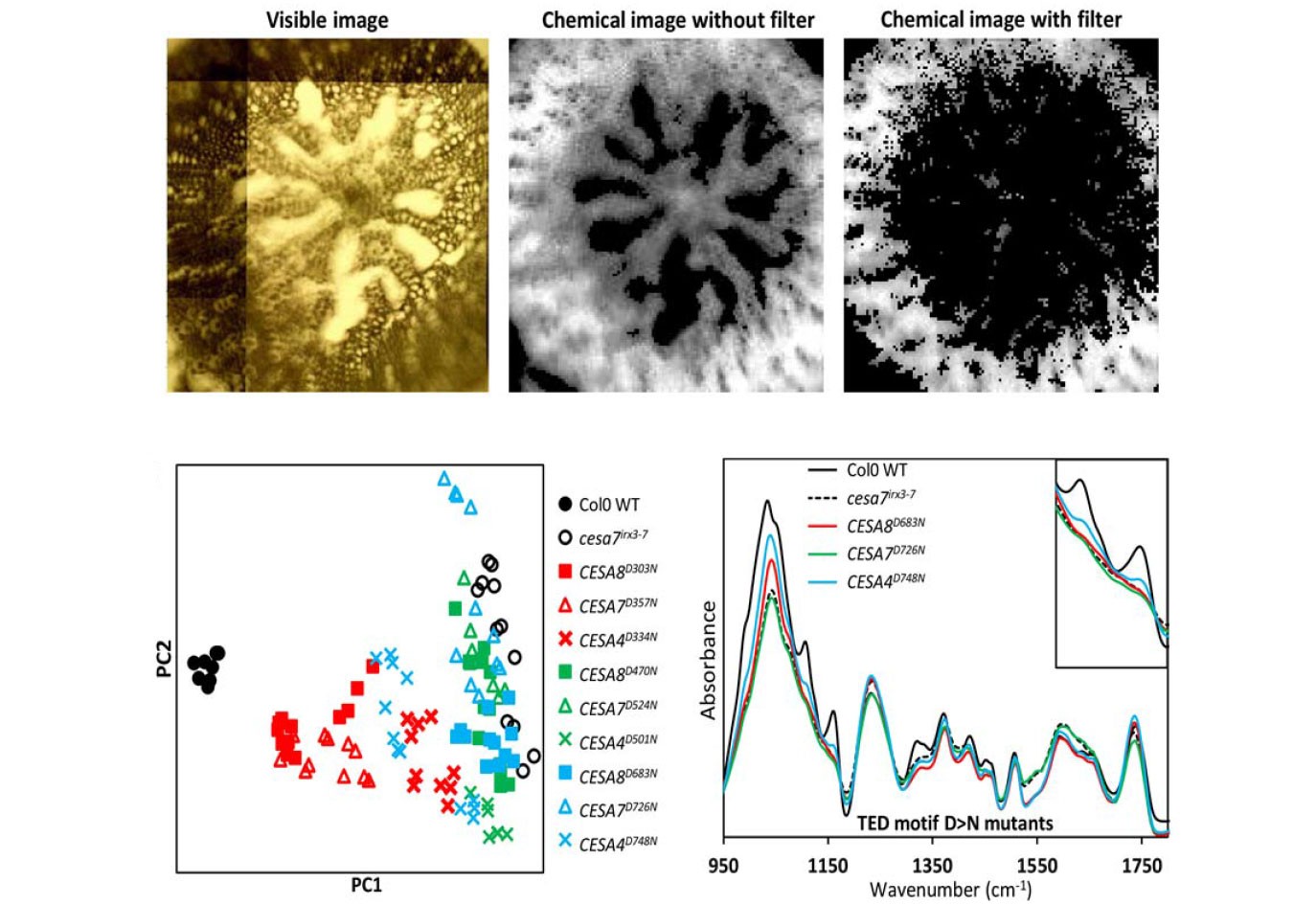博文
Plant Physiology:植物纤维素合酶对于纤维素微纤丝结构的作用
||
Exploiting CELLULOSE SYNTHASE (CESA) class-specificity to probe cellulose microfibril biosynthesis
First author: Manoj Kumar; Affiliations: University of Manchester (曼彻斯特大学): Manchester, UK
Corresponding author: Simon R. Turner
Cellulose microfibrils (纤维素微纤丝) are the basic units of cellulose in plants. The structure of these microfibrils is at least partly determined by the structure of the cellulose synthase complex. In higher plants, this complex is composed of 18 to 24 catalytic subunits known as CELLULOSE SYNTHASE A (CESA) proteins. Three different classes of CESA proteins are required for cellulose synthesis and for secondary cell wall cellulose biosynthesis, which include CESA4, CESA7, and CESA8. To probe the relationship between CESA proteins and microfibril structure, we created mutant cesa proteins that lack catalytic activity but retain sufficient structural integrity to allow assembly of the cellulose synthase complex. Using a series of Arabidopsis mutants and genetic backgrounds, we found consistent differences in the ability of these mutant CESA proteins to complement the cellulose-deficient phenotype of the cesa null mutants. The best complementation was observed with catalytically inactive cesa4 while the equivalent mutation in cesa8 exhibited significantly lower levels of complementation. Using a variety of biophysical techniques, including ssNMR and FTIR, to study these mutant plants we found evidence for changes in cellulose microfibril structure, but these changes largely correlated with cellulose content and reflected differences in the relative proportion of primary and secondary cell walls. Our results suggest that individual CESA classes have similar roles in determining cellulose microfibril structure, and it is likely that the different effects of mutating members of different CESA classes is a consequence of their different catalytic activity and their influence on the overall rate of cellulose synthesis.
纤维素微纤丝是植物纤维素的基本组成单位。纤维素合酶复合物的结构部分决定了这些微纤丝的结构。在高等植物中,纤维素合酶复合物由18到24的催化亚基组成,这些催化亚基就是纤维素合酶CESA蛋白。三个不同的纤维素合酶蛋白CESA4、CESA7和CESA8作用于纤维素合成和次生细胞壁纤维素的生物合成。为了研究CESA蛋白和微纤丝结构之间的关系,作者构建了cesa蛋白突变体,该突变体虽然缺失了催化活性,但仍保留了足够的结构完整性能够形成纤维素合酶复合物。利用一系列的拟南芥突变体和遗传背景,作者发现在这些CESA蛋白互补cesa无效突变体纤维素缺陷表型的能力存在连续的差异。其中,cesa4催化失活具有最好的互补表现,而cesa8的等效突变存在最低水平的互补表现。利用一些诸如ssNMR和FTIR等生物物理的工具,作者研究了这些突变体的表型,并鉴定了纤维素微纤丝结构的改变,但这些改变与纤维素含量相关,反应了初生和次生细胞壁相对比例的差异。本文的结果表明不同的CESA蛋白在决定纤维素微纤丝结构方面具有类似的作用,而不同CESA突变体的差异可能是其催化活性的不同以及对于纤维素合酶整体速率的影响不同所导致的。
通讯:Simon R. Turner (https://www.research.manchester.ac.uk/portal/simon.turner.html)
�
�个人简历:1979-1982年,英国布里斯托大学,生物化学学士;1984-1998年,约翰英纳斯中心,博士。
研究方向:纤维素生物合成;纤维素合酶复合物与纤维素微纤丝结构之间的关系;植物维管发育。
doi: https://doi.org/10.1104/pp.18.00263
Journal: Plant Physiology
Published date: 28 March, 2018
(P.S. 欢迎关注微信公众号:微信号Plant_Frontiers)
https://blog.sciencenet.cn/blog-3158122-1106425.html
上一篇:Developmental Cell:拟南芥生物钟通过细胞周期调控植物生长
下一篇:the plant journal:黄瓜CsSPL基因作用于花药和胚珠的生长发育
全部作者的其他最新博文
- • Plant Physiology:CsMADS3促进柑果中的叶绿素降解和类胡萝卜素合成(华中农业大学)
- • Molecular Plant:LBD11-ROS反馈调节作用于拟南芥的维管形成层增殖和次生生长(浦项科技大学)
- • Science Advances:根结线虫通过调控植物的CLE3-CLV1模块,促进侵染进程(日本熊本大学)
- • Nature Communications:油菜素内酯参与植物营养生长期转变的分子机制解析(浙江农林大学)
- • Current Biology:光合作用产生的蔗糖驱动侧根“生物钟”(德国弗莱堡大学)
- • PNAS:花同源异型基因在叶中被抑制、花中被激活的分子机制(南卡罗来纳大学)

